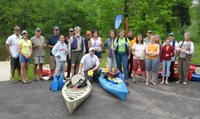King Coal De-Throned?
Sometimes, tradition can be expensive.
Consider the choice faced by county commissioners in Schuylkill County, who are considering a proposal to replace the heating system in their prison and county courthouse with natural gas.
Why? Because it's cheaper.
Seems like a no-brainer right? It would be if this weren't Schuylkill County.
Everything but the milkshakes in Schuylkill County is made from coal and event those have a touch of the ambient coal dust that fills the air. The heart of Pennsylvania's "coal regions," coal is the only game in town -- anthracite coal to be exact.
Called "black diamond," anthracite coal is harder and burns cleaner than its more sulphuric cousin, bituminous coal.
It gets that way by being deeper under the mountains, and thus being under more pressure. This, however, makes it even harder to get to and thus more expensive and more dangerous to extract.
And in Schuylkill County and its environs, they have paid a bittersweet toll for the resource that defines them. Since 1870, more than 30,000 people have died to bring those black diamonds to the surface.
Without that sacrifice, America would be a different place.
Pottstown and Phoenixville and Royersford all would be different places.
Coal was the foundation of the Industrial Revolution that transformed us from a backwards oddity in Europe's shadow, to a world power whose "white fleet" of battleships sailed round the world under Teddy Roosevelt's order, signalling to all that there was a new kid on the block.
Closer to home, it was that coal -- filling canal boats that came down the Schuylkill River Navigation toward Philadelphia, and later in the cars of the Reading and Pennsylvania railroads -- that transformed our towns from the farmer's markets they were into the industrial hubs that defined them.
Without anthracite, there would have been no Bethlehem Steel, no Phoenix Steel, no Glasgow Iron Works or Doehler-Jarvis.
Anthracite was the choice of those industrial boilers and furnaces. It burns hotter because it's sulphur content is low, meaning it makes less of the sulphur-based gas that forms acid rain.
That's good.
But it also has a higher carbon content, which means it is no slouch in the production of carbon dioxide when it's burned.
In these days of global warming, that's bad.
I have a piece of "black diamond" sitting on my desk that I picked up at a mine during a visit to Schuylkill County several years ago while covering one of the first Schuylkill Watershed Congress meetings.
I keep it there in recognition that this rock made us. It warmed our homes and fueled the jobs that fed our families.
True, that should not be taken lightly, but it also should not be carried as a burden into a dead-end future based on an outdated and unhealthy technology.
Time, like the river that cleaned the coal and carried the boats that carried it to market, has moved on. Those industries no longer define us -- nor should the rock that fueled them.
Nowhere is that lesson having more trouble taking hold than in Schuylkill County, where James J. Rhoades, a Republican state senator, has objected to considering the use of natural gas to power the courthouse and prison.
"Heritage should account for something," he told The New York Times for a June 10 article.
He's right. And it does. But heritage is not a plan for the future.
Fossil fuels are finite.
Period.
They are undoubtedly our heritage, but there is much doubt about whether they can sustainably represent our future.
Eventually, we will run out, either because of the difficulty of obtaining it, or because the market makes it too expensive to use.
We are long past the time when we should have begun working on alternatives, the next wave of energy.
Before coal, we burned wood and the forests fell.
Then, after coal, we burned oil and have ever since.
But we are now living in the age of oil's decline and anthracite's last gasps should serve as a warning of what's to come. And because we've put off recognizing this reality for so long, we have just about missed the opportunity for a smooth transition.
Instead, the blinders we've worn as a nation have guaranteed us a rocky road over the next few years.
We should let Schuylkill County's example be a lesson to us all. It makes no sense to cling tenaciously to an industry -- promises of "clean coal" aside -- for which we can no longer afford the environmental price, anymore than we can afford a gallon of gasoline.
And we are paying the price of transition as we stagger through the wrenching ups and downs in search of alternatives like ethanol and geo-thermal and solar in an atmosphere of crisis instead of the calm starting eight to ten years ago might have allowed.
As the gas price crisis gets worse, each mistake we make in the field of alternatives becomes much more costly and seems to undermine its viability out of proportion to the technical problem it represents.
Surely, oil encountered technical problems along the way, but it was allowed to perfect its technology while the world chugged along happily on coal power, each mistake just part of the process of perfecting the process.
What Schuylkill County is going through now is merely a microcosm of what the rest of the nation faces.
Their proposed solutions -- protectionist laws that banned natural gas pipelines from crossing their borders, requiring that all public buildings use coal in order to preserve local jobs -- are not for the long-term.
They are a denial of the coming changes, not necessarily natural gas but definitely not coal, based on fear of any change.
Times change and we have to change with them.
Labels: anthracite, coal, coal regions, Schuylkill
 RSS
RSS


